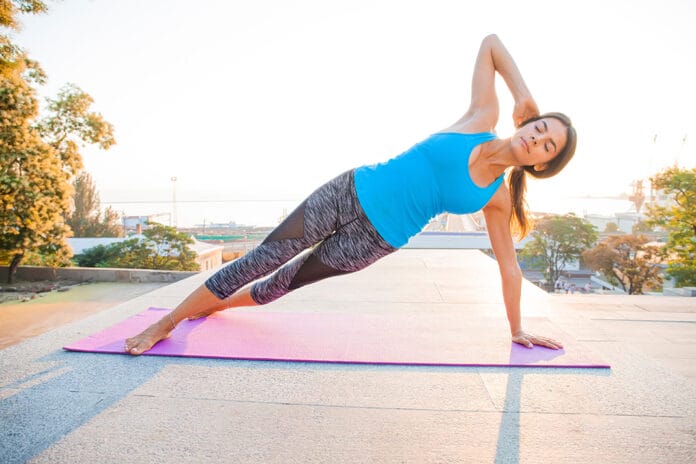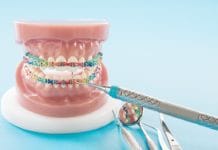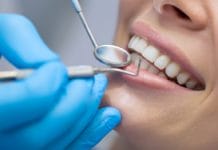The core, a group of midsection body muscles, is essential to strengthen and maintain for overall health. The back is one of the most compromised groups of muscles and ligaments in the dental profession ‒ even with good ergonomics. A static, unnatural position can initiate or accelerate an injury, whether short-term or long-term. Depending on the patient or self-induced bad habits, dental professionals may lean toward a certain side or too far forward over the patient for hours a day, which can become debilitating.
As it comes with the territory of dentistry, we are positioned to crouch over patients, causing more harm than we know to our bodies. Leaning over dental patients strains our hip flexors, low back, pelvis, and glutes. Sitting with poor posture can shift our body out of alignment over time, and when that happens, other parts of our body compensate for the overstrained areas.
Core Muscles
The core is more than just the abdominals or back; it comprises 29 muscles. It covers the areas between the abdominals in the front, the paraspinals and gluteals in the back, the diaphragm at the top, and the pelvic floor and hip girdle at the bottom.1
The core muscles provide postural control and stability by sparing the spine from an excessive load and help in the power shift between the upper and lower body.2 The stronger the core, the more powerful and effective the trunk maneuvers.
The muscles in the front work in flexing and bending the body forward. The side muscles help twist and move side to side. The back muscles aid in bending the body backward. The upper muscles work with expanding the chest for breathing, controlling intra-abdominal pressure, and spine stabilization. Other muscles include the gluteals, which stretch onto the backside of the pelvis and move the hips. The pelvic muscles help control urination, bowel movements, the bladder, and other lower organs.
The core muscles contain two main muscle groups:
Stabilizers ‒ Just as the name implies, the muscles stabilize the spine and body. They are the deep and shorter muscles and are the slow twitch fibers. These fibers contract slowly, produce a weaker force, provide longer endurance, and are used for low impact and long activities. They also control the intersegmental motion required for postural and extrinsic loading responses. These muscles provide stability during movements such as thigh extension and rotation and hold the spine stable during movement.
- The transverse abdominis is the deepest of the abdominals known as the corset muscles, reaching from the ribs to the pelvis. It helps with deep breathing, bending, and rotating side to side.
- The multifidus extends from the axis to the sacrum and stabilizes the joints in the spine.
- Internal obliques are side muscles to aid in twisting side to side and spinal protection.
- The diaphragm is located at the bottom of the ribcage and supports breathing as it contracts during inhaling and exhaling.
- Glutes include the trio of maximus, medius, and minimus muscles. They extend the hips, rotate the obliques, flex the torso, and stabilize the spine and pelvis
- The pelvic floor houses internal organs, including the urethra, bladder, intestines, rectum, uterus, and cervix. It also stabilizes the hips, hamstrings, and abductors.1 The pelvic floor muscles areimportant during pregnancy and birth.
Global movers ‒ Just as the name implies, they help with the body’s movement, are the superficial and longer muscles, and are the fast twitch fibers. These fibers contract fast, producing greater force, fatiguing quickly, and are used for high-intensity but short activities. They produce large amounts of torque and gross movements. These muscles assist with generating movements such as rotation, breathing, bending side to side, forward bending, and standing up straight.
- External obliques are side muscles that move the entire trunk up, down, around, and side to side.
- Erector spinae expands along the length of your spine and is used to rotate the trunk side to side and enhance good posture.
- Rectus abdominis (the six-pack abs) initiates movements of the spine, vertical column, and pelvis.
- Latissimus is the widest muscle that covers most of the back and connects the arms to the spine, and runs down to the pelvis, working with the obliques for trunk rotation
- Quadratus lumborum is paired muscles extending from the lowest rib (12th) to the pelvis (iliac crest). It is the deepest back muscle and is correlated with back pain, posture, and mobility issues.1,2
Core Syndromes
A couple of conditions relating to the core that affect dental professionals are worth mentioning. Back pain can be a central concern to a dental professional’s occupational health. It would be a disservice not to mention some disorders, as good ergonomics is important to maintain a healthy posture to prevent injury.
Quadratus lumborum syndrome ‒ Quadratus lumborum syndrome is one of the most common sources of low back pain. The weakness of the back extensor muscles can put the load onto the quadratus lumborum and cause pain. It can be a deep ache or sharp pain. It commonly occurs during rest but may worsen with movement such as walking, standing, or rolling over in bed. It can be acute or become chronic, caused by overuse, weakness, strain, tightness, and tension of the back.
Sitting too long can cause continual contractions or tightening, leading to fatigue. With a lack of blood flow, it can become stiff and painful. Long-term standing can place extra strain on the quadratus lumborum and cause pain.
If this muscle is weak, other muscles around the pelvic area and quads will kick in to pick up the slack and cause tension. Weak muscles have more strain put on them to fulfill their function, therefore increasing the risks of injuries and pain.
Trigger points (muscle knots) are sensitive areas of muscles or connective tissue and hurt when activated or pressed. These points radiate when irritated and cause deep lower back pain or stabbing sensation in the hips or pelvis. When the quadratus lumborum is shortened, it promotes a sharp pain when coughing or sneezing.3 This isn’t to be confused with sciatica. Sciatica pain is usually unilateral and radiates along the sciatica nerve from the lower back through the hips, buttocks, and down the back of each leg through the thigh and calf.
If quadratus lumborum pain is untreated, it may radiate to the hips, buttocks, thighs, sacroiliac joint, low back, and abdominal. Prevention is key to maintaining a strong core for good posture while sitting, standing, lifting, and other activities.
Psoas muscle syndrome ‒ The psoas muscle syndrome is rare and happens when the deep psoas muscles tighten or spasm. These deep muscles are about 16 inches long and connect from the thoracic spine (T12), travel along the lumbar spine, run through the groin, and connect to the femur’s top. It’s the only muscle that connects the spine to the leg. It functions as a hip flexor to bring the trunk and legs together, straightens the lower spine, and is used with side bending.
Tight psoas muscles can cause pressure on the lower lumbar discs and contribute to lower back pain. Also, tight muscles can restrict the movement of the transverse abdominis. When the lower back is inhibited, kyphosis can develop which is an excessive curvature and hunching of the shoulders and upper back.
If the muscles become inflamed, the adjacent tissues can absorb the excessive pressure and cause abdominal and groin pain with the sensation of heat or running water along the front of the thigh.
The psoas muscles can shorten over time due to sitting positions or leaning forward with poor posture. It can eventually cause shortening of the front of the body, causing tightness of the abdominal muscles, impingement of the blood vessels and nerves, and a decreased diaphragmatic function. Overall, it changes the posture negatively.
Psoas muscle syndrome includes general tightness and pain, causing restriction of movement and mobility in the front of the hips and buttocks, difficulty standing up tall or taking long steps and limping while walking, and pain radiating down the leg in association with back pain.4
Benefits of a Strong Core
The luxury of a strong back is wonderful since it adds to the quality of life. A strong core facilitates posture, balance, and stability. When the core muscles attached to the spine are strong, it supports a healthy posture.
A healthy posture improves many aspects of daily activities, including reduced low back, neck, and shoulder pain as well as TMJ issues. A good posture contributes to fewer headaches, less wear of the joints, improved circulation, digestion, lung capacity, and breathing. It also provides a better form for workouts or daily activities and can make one appear taller. In addition, an aligned posture keeps everything else in place, such as the head, shoulders, hips, knees, and ankles.5
A strong core improves balance by allowing multi-directional movement of the body, walking on flat, uneven, or bumpy terrain, or simply just standing.
A strong core provides stability for lifting, twisting, and moving. It also lowers the risk of muscle injuries, lower back pain, and poor posture.
A strong core is beneficial for repetitive movements, decreases falls and injuries, and provides dynamic, explosive, and powerful movements. It enhances everyday activities of household chores, dressing, bathing, rising, and sitting in a chair. A strong core is essential in dentistry because we are constantly sitting, standing, twisting, reaching, turning, moving, adjusting our chair position, and bending forward.
Signs of a Weak Core
Having a weak or imbalanced core can lead to multiple issues in the body. Gravity can pull the shoulders forward with an unbalanced core, adding unnecessary strain on the neck and upper back. Weak core muscles can compromise the quality of life through poor posture, lower back pain, and muscle injuries. In addition, it can lead to more fatigue and less endurance in many activities. An imbalanced core doesn’t only lead to a sore back but also knee, neck, and hip issues.6
Poor posture with weak core muscles may also cause musculoskeletal disorders. An unstable posture causes an excessive force on the joints and overloads the muscles and tendons. Joint efficiency requires a mid-range of motion, and when it doesn’t operate naturally, recovery is slower. When the muscles are strained and imbalanced over time and repeatedly, the risk of musculoskeletal disorders can increase. Musculoskeletal disorders can cause chronic pain and, in turn, make treating patients difficult, interfere with daily life activities outside of work, and even decrease quality of life. Musculoskeletal disorders may lead to missing work which decreases a clinician’s income and may shorten a clinician’s career altogether.
A way to tell if the core muscles are weak is poor posture or pain when trying to have proper posture, poor balance, back pain with muscle soreness or injury, and after standing or sitting for a long time. A sign of a weak core is if the abdomen can’t be pulled in during a plank or push-up and if the neck or back is sorer after a workout as it compensates for the core.
A super arched lower back or walking with an anterior pelvis tilt causing the glutes and hip flexors to compensate for an off-balanced pelvis is another cause of a weak core. Recurrent low back pain can be a sign of weak core muscles, as it can be a misaligned lumbar spine putting pressure on the vertebrae, discs, and muscles. Needing help or holding onto something when standing or getting up from a chair or out of bed.6
Menopause and the Pelvic Floor
Women tend to have smaller back muscles than men, and the hormonal changes with menopause can cause weak pelvic muscles. The pelvic floor, which is considered the bottom part of the core muscles, consists of internal organs, hamstrings, hip flexors, and abductors. The pelvic floor muscles help with hip stabilization, urination, bowel movements, and sex. With the onset of menopause, the pelvic floor muscles naturally weaken, and weight gain during this time can increase the weakness.7
Patients and Their Core
The core is a prominent feature from a baby to the elderly. As a baby, the core is important for overall health and development. It allows the baby to be in a prone position or lying on their back while they play. It provides stability to the whole body and plays a powerful role in sitting, crawling, rolling, and holding the head up ‒ then eventually walking, playing, moving, and exploring.8
As young kids and teenagers, the core is important for gross motor skills. Strong core muscles are most important for healthy motor development in children.
Signs of a weak core in youthful patients:
- May be fidgeting while standing or sitting and trying to get comfortable
- Leaning on things for stability, such as walls, furniture, or other people
- Leaning on the hands while seated to keep the head up
- Slumping while seated or standing
- Balance issues when active
- Challenge to transition from one position to another
- Unable to keep back upright when dressing or sitting
- Difficulty with bilateral coordination9
W-sitting is another red flag for poor core strength. It gives the child a wide base and more stability with minimal core use. This may decrease postural strength, balance, and stability. It also limits bilateral weight shifting, promotes shortened or tight hip and leg muscles, and can cause pelvic pain.10
For the elderly, the core is mostly important for balance and stability as the elderly are more susceptible to injuries caused by falls. Degenerative changes happen in the spine during aging and wear down the bones and cartilage. Preventing and avoiding injuries is healthier than healing from an injury. Keeping a strong core as we age is crucial for range of motion, reducing pain, and accomplishing daily activities of walking, driving, getting up and down from a chair, bathing, and dressing. A strengthened core can also prolong independent living.11
Some core therapies include:
- Core exercises such as planks, hip lifts, dead bugs, and glute bridges.
- Stretches, Pilates, yoga
- Maintaining a healthy weight
- Maintain good posture
- Chiropractor
- Massage
- Active sitting (Sitting in a way the muscles have to work for good posture rather than sitting passively: core engaged, such as the abdominal muscles sucked in, back straight, shoulders down and back.)
Improving core strength is key to longevity in the dental field. Multiple exercises, habits, and therapies can become a daily routine for a strong core of hard-working dental professionals. Having a solid core is the difference between constantly struggling with pain and the ease of comfortable movement.
Before you leave, check out the Today’s RDH self-study CE courses. All courses are peer-reviewed and non-sponsored to focus solely on pure education. Click here now.
Listen to the Today’s RDH Dental Hygiene Podcast Below:
References
- Core Muscles. (n.d.). https://www.physio-pedia.com/Core_Muscles
- Dhameliya, N. (2021, August 27). List of Core Muscles. Mobile Physiotherapy Clinic. https://mobilephysiotherapyclinic.in/list-of-core-muscles/
- Quadratus Lumborum Syndrome. (n.d.). Physiopedia. https://www.physio-pedia.com/Quadratus_Lumborum_Syndrome
- Psoas Syndrome. (2018, November 13). Cleveland Clinic. https://my.clevelandclinic.org/health/diseases/15721-psoas-syndrome
- Jonaitis, J. (2020, April 13). These 12 Exercises Will Help You Reap the Health Benefits of Good Posture. https://www.healthline.com/health/fitness-exercise/posture-benefits
- Kassel, G. (2018, November 29). 5 Clues Your Body is Compensating for a Weak Core—and How to Deal. Well+Good. https://www.wellandgood.com/weak-core/
- Walters, O. (2022, March 7). 11 Benefits of a Strong Core. https://www.healthline.com/health/core-strength-more-important-than-muscular-arms
- Parents’ Guide to Baby’s Core. (n.d.). https://pathways.org/watch/parents-guide-to-babys-core/
- Heffron, C. (2015, November 10). Building Core Muscles: Red Flags for Kids. The Inspired Treehouse. https://theinspiredtreehouse.com/how-to-tell-if-your-child-has-weak-core-muscles/
- What is W-Sitting? (n.d.). Pathways. https://pathways.org/what-is-w-sitting/
- The Best Core Exercises for Seniors. (2015, December 08). American Senior Communities. https://www.asccare.com/the-best-core-exercises-for-seniors/













